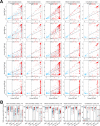This is a preprint.
Maturation of SARS-CoV-2 Spike-specific memory B cells drives resilience to viral escape
- PMID: 36203553
- PMCID: PMC9536037
- DOI: 10.1101/2022.09.30.509852
Maturation of SARS-CoV-2 Spike-specific memory B cells drives resilience to viral escape
Update in
-
Maturation of SARS-CoV-2 Spike-specific memory B cells drives resilience to viral escape.iScience. 2023 Jan 20;26(1):105726. doi: 10.1016/j.isci.2022.105726. Epub 2022 Dec 5. iScience. 2023. PMID: 36507220 Free PMC article.
Abstract
Memory B cells (MBCs) generate rapid antibody responses upon secondary encounter with a pathogen. Here, we investigated the kinetics, avidity and cross-reactivity of serum antibodies and MBCs in 155 SARS-CoV-2 infected and vaccinated individuals over a 16-month timeframe. SARS-CoV-2-specific MBCs and serum antibodies reached steady-state titers with comparable kinetics in infected and vaccinated individuals. Whereas MBCs of infected individuals targeted both pre- and postfusion Spike (S), most vaccine-elicited MBCs were specific for prefusion S, consistent with the use of prefusion-stabilized S in mRNA vaccines. Furthermore, a large fraction of MBCs recognizing postfusion S cross-reacted with human betacoronaviruses. The avidity of MBC-derived and serum antibodies increased over time resulting in enhanced resilience to viral escape by SARS-CoV-2 variants, including Omicron BA.1 and BA.2 sub-lineages, albeit only partially for BA.4 and BA.5 sublineages. Overall, the maturation of high-affinity and broadly-reactive MBCs provides the basis for effective recall responses to future SARS-CoV-2 variants.
Figures






References
-
- Bowen J.E., Addetia A., Dang H.V., Stewart C., Brown J.T., Sharkey W.K., Sprouse K.R., Walls A.C., Mazzitelli I.G., Logue J.K., et al. (2022a). Omicron spike function and neutralizing activity elicited by a comprehensive panel of vaccines. Science, eabq0203. 10.1126/science.abq0203. - DOI - PMC - PubMed
-
- Bowen J.E., Sprouse K.R., Walls A.C., Mazzitelli I.G., Logue J.K., Franko N.M., Ahmed K., Shariq A., Cameroni E., Gori A., et al. (2022b). Omicron BA.1 and BA.2 neutralizing activity elicited by a comprehensive panel of human vaccines. bioRxiv, 2022.2003.2015.484542. 10.1101/2022.03.15.484542. - DOI - PubMed
Publication types
Grants and funding
LinkOut - more resources
Full Text Sources
Miscellaneous
